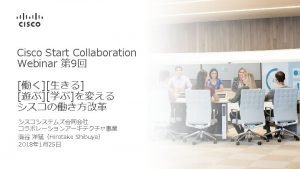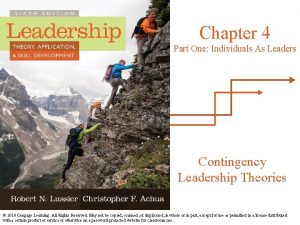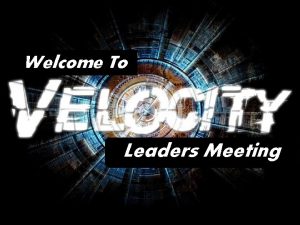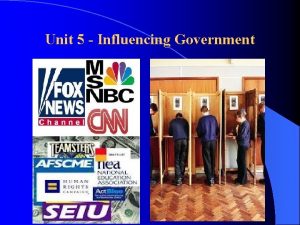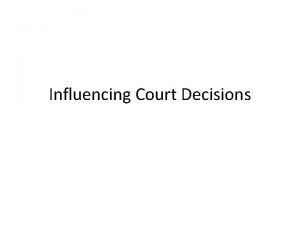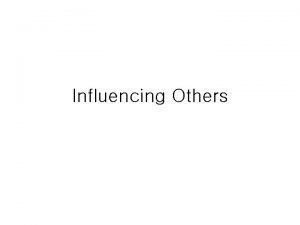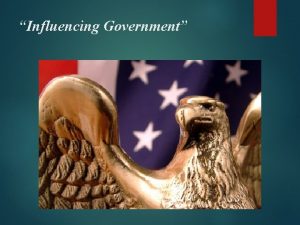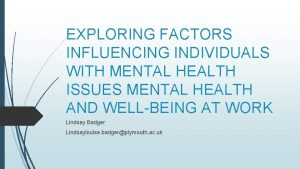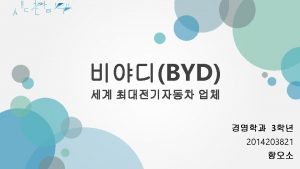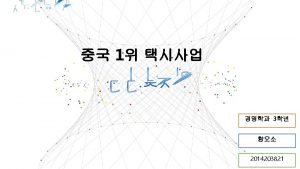Chapter 5 Part One Individuals As Leaders Influencing
























- Slides: 24

Chapter 5 Part One: Individuals As Leaders Influencing: Power, Politics, Networking, and Negotiation © 2016 Cengage Learning. All Rights Reserved. May not be copied, scanned, or duplicated, in whole or in part, except for use as permitted in a license distributed with a certain product or service or otherwise on a password-protected website for classroom use. 5 -

Learning Outcomes 1) Explain the differences between position power and personal power. 2) Discuss the differences among legitimate, reward, coercive, and referent power. 3) Discuss how power and politics are related. 4) Describe how money and politics have a similar use. 5) List and explain the steps in the networking process. 6) List the steps in the negotiation process. 7) Explain the relationships among negotiation and conflict, influencing tactics, power, and politics. © 2016 Cengage Learning. All Rights Reserved. May not be copied, scanned, or duplicated, in whole or in part, except for use as permitted in a license distributed with a certain product or service or otherwise on a password-protected website for classroom use. 5 -2

Power • Power is the leader’s potential influence over followers. > Power is the potential to influence, not the actual use of power. • There are two sources of power: > Position power is delegated, and > Personal power is derived from the followers. > Successful managers push power down the chain of command (empowerment). • There are seven types of power. See Exhibit 5. 1. © 2016 Cengage Learning. All Rights Reserved. May not be copied, scanned, or duplicated, in whole or in part, except for use as permitted in a license distributed with a certain product or service or otherwise on a password-protected website for classroom use. 5 -3

Legitimate Power • Legitimate power is based on the user’s position power, given by the organization. > Appropriate use – when asking someone to do something within their job scope. > Helpful to use the consultation influencing tactic. o Also known as participative management and empowering employees. © 2016 Cengage Learning. All Rights Reserved. May not be copied, scanned, or duplicated, in whole or in part, except for use as permitted in a license distributed with a certain product or service or otherwise on a password-protected website for classroom use. 5 -4

Rational Persuasion • Managers find the rational persuasion influencing tactic helpful. • Guidelines for a rational persuasion: > > Explain why objective needs met, Explain how meeting the objective benefits the other party, Provide evidence the objective can be met, and Explain how problems/concerns will be handled. • When persuading others, the ingratiation influencing tactic is helpful. > Give praise before asking for what you want. © 2016 Cengage Learning. All Rights Reserved. May not be copied, scanned, or duplicated, in whole or in part, except for use as permitted in a license distributed with a certain product or service or otherwise on a password-protected website for classroom use. 5 -5

Increasing Legitimate Power Guidelines for increasing legitimate power: > Increase management experience, o Could be part of the job such as team leader. > Exercise authority regularly, o Follow up making sure objectives are met. > Follow rational persuasion guidelines, o Especially when authority is questioned. > Back up your authority with rewards and punishment. © 2016 Cengage Learning. All Rights Reserved. May not be copied, scanned, or duplicated, in whole or in part, except for use as permitted in a license distributed with a certain product or service or otherwise on a password-protected website for classroom use. 5 -6

Reward Power • Reward power is based on the user’s ability to influence others with something of value to them. • Appropriate use: > Employees should be rewarded for doing a good job. > Managers find the exchange influencing tactic helpful when dealing with others over whom they have no authority. © 2016 Cengage Learning. All Rights Reserved. May not be copied, scanned, or duplicated, in whole or in part, except for use as permitted in a license distributed with a certain product or service or otherwise on a password-protected website for classroom use. 5 -7

Increasing Reward Power Guidelines for increasing reward power: > Gain and maintain control over evaluating employees’ performance, o and determining raises, promotions, and other rewards. > Find out what others value, o and reward people in that way. > Let people know you control rewards, o and state your criteria for giving rewards. © 2016 Cengage Learning. All Rights Reserved. May not be copied, scanned, or duplicated, in whole or in part, except for use as permitted in a license distributed with a certain product or service or otherwise on a password-protected website for classroom use. 5 -8

Coercive Power • The use of coercive power involves punishment and withholding of rewards to influence compliance – also called the pressure influencing tactic. > Appropriate use of coercive power is while maintaining discipline and enforcing rules. • Guidelines for increasing coercive power: Gain authority to use punishment and withhold rewards, o Don’t make rash threats, and o Be persistent. o © 2016 Cengage Learning. All Rights Reserved. May not be copied, scanned, or duplicated, in whole or in part, except for use as permitted in a license distributed with a certain product or service or otherwise on a password-protected website for classroom use. 5 -9

Referent Power • Referent power is based on the user’s personal relationships with others – also called the personal appeals influencing tactic. • Leaders can use the inspirational appeals influencing tactic. • Referent power is appropriate for people with weak, or no, position power. • Increasing referent power: > Develop your people skills, and > Work at your relationships with managers and peers. © 2016 Cengage Learning. All Rights Reserved. May not be copied, scanned, or duplicated, in whole or in part, except for use as permitted in a license distributed with a certain product or service or otherwise on a password-protected website for classroom use. 5 - 10

Expert Power • Expert power is based on the user’s skill and knowledge. > Often use rational persuasion influencing tactic. • Appropriate uses: > New managers rely on employees’ expertise. • Guidelines for increasing expert power: > Increase training to become an expert, > Attend trade meetings, etc, > Keep up with latest technology, and > Project a positive self-concept and develop a reputation for having expertise. © 2016 Cengage Learning. All Rights Reserved. May not be copied, scanned, or duplicated, in whole or in part, except for use as permitted in a license distributed with a certain product or service or otherwise on a password-protected website for classroom use. 5 - 11

Information Power • Information power is based on the user’s data desired by others. • Appropriate use of information power: > When making rational persuasion or inspirational appeals. • Guidelines for increasing information power: > Have information flow through you, > Know what is going on in the organization, and > Develop a network of information sources. © 2016 Cengage Learning. All Rights Reserved. May not be copied, scanned, or duplicated, in whole or in part, except for use as permitted in a license distributed with a certain product or service or otherwise on a password-protected website for classroom use. 5 - 12

Connection Power • Connection power is based on the user’s relationships with influential people. > Leaders use a coalition influencing tactic when persuading others – a political strategy. • Appropriate use of connection power: > When looking for a job or a promotion. • Guidelines to increasing connection power: > > Expand your network to managers with power, Join the “in-crowd” and “right” associations, Follow guidelines for the coalition influencing tactic, and Get people to know your name. © 2016 Cengage Learning. All Rights Reserved. May not be copied, scanned, or duplicated, in whole or in part, except for use as permitted in a license distributed with a certain product or service or otherwise on a password-protected website for classroom use. 5 - 13

The Nature of Organizational Politics • Politics is the process of gaining and using power – power and politics are related. • Politics is a social medium of exchange. > Like money, politics is neither good nor bad, o Simply a system of getting what you want. > Money is the economic medium of exchange, > Politics is the organizational medium of exchange. © 2016 Cengage Learning. All Rights Reserved. May not be copied, scanned, or duplicated, in whole or in part, except for use as permitted in a license distributed with a certain product or service or otherwise on a password-protected website for classroom use. 5 - 14

Political Behavior • Networking is the process of developing relationships for the purpose of socializing and politicking. • Reciprocity involves creating obligations and developing alliances, and using them to accomplish objectives. • Using coalitions as an influencing tactic. > Use co-optation to get a person to join your coalition rather than compete against you. o See Exhibit 5. 2. © 2016 Cengage Learning. All Rights Reserved. May not be copied, scanned, or duplicated, in whole or in part, except for use as permitted in a license distributed with a certain product or service or otherwise on a password-protected website for classroom use. 5 - 15

Political Skills Guidelines for developing political skills: > Learn the organizational culture and power players. o Learn to read between the lines. > Develop good working relationships, especially with your manager. o Use the ingratiation tactic with everyone. > Be a loyal, honest team player. o Work at being a team player. > Gain recognition. © 2016 Cengage Learning. All Rights Reserved. May not be copied, scanned, or duplicated, in whole or in part, except for use as permitted in a license distributed with a certain product or service or otherwise on a password-protected website for classroom use. 5 - 16

Networking • “Career” networking is more than a Facebook account. • The Networking Process: 1. 2. 3. 4. 5. Perform a self-assessment and set goals, Create your one-minute self-sell, Develop your network, Conduct networking interviews, and Maintain your network. © 2016 Cengage Learning. All Rights Reserved. May not be copied, scanned, or duplicated, in whole or in part, except for use as permitted in a license distributed with a certain product or service or otherwise on a password-protected website for classroom use. 5 - 17

Self-Assessment, Goals and One-Minute Self-Sell • Self-assessment can clarify your skills, competencies and knowledge. > Accomplishments. > Tie accomplishments to the job interview. > Set networking goals. • The one-minute self-sell is an opening statement used in networking that quickly summarizes your history and career plan and asks a question. > Part 1. History, > Part 2. Plans, and > Part 3. Question. © 2016 Cengage Learning. All Rights Reserved. May not be copied, scanned, or duplicated, in whole or in part, except for use as permitted in a license distributed with a certain product or service or otherwise on a password-protected website for classroom use. 5 - 18

Develop and Maintain Your Network • Begin with who you know. • Categorize your list into professional and personal contacts. • Expand your list to people you don’t know. • Develop your ability to remember people by name. • After building your network, maintain it. • Although many companies encourage employees to use social media. > Know the company policy and follow the rules. © 2016 Cengage Learning. All Rights Reserved. May not be copied, scanned, or duplicated, in whole or in part, except for use as permitted in a license distributed with a certain product or service or otherwise on a password-protected website for classroom use. 5 - 19

Conduct Networking Interviews Networking in person is important. > Step 1. Establish a Rapport. > Step 2. Deliver One-Minute Self-Sell. > Step 3. Ask Prepared Questions. > Step 4. Get Additional Contacts for Your Network. > Step 5. Ask Your Contacts How You Might Help Them. > Step 6. Follow Up with a Thank-You Note and Status Report. © 2016 Cengage Learning. All Rights Reserved. May not be copied, scanned, or duplicated, in whole or in part, except for use as permitted in a license distributed with a certain product or service or otherwise on a password-protected website for classroom use. 5 - 20

Negotiation • Negotiating is a process in which two or more parties have something the other wants and attempt to come to an agreement. > An essential career skill. > Directly affects your success. > Influencing tactics, power and politics used often. • Negotiations are appropriate in all situations without a fixed price or deal. > All parties should believe they got a good deal. o Negotiation does not have to be a zero-sum game. © 2016 Cengage Learning. All Rights Reserved. May not be copied, scanned, or duplicated, in whole or in part, except for use as permitted in a license distributed with a certain product or service or otherwise on a password-protected website for classroom use. 5 - 21

The Negotiation Process The key is preparation. Face-to face is preferred. Know what is being negotiated. Agreement? Put it in writing and stop selling. Take your time. If no progress, postpone. No Agreement? Analyze and improve for the future. © 2016 Cengage Learning. All Rights Reserved. May not be copied, scanned, or duplicated, in whole or in part, except for use as permitted in a license distributed with a certain product or service or otherwise on a password-protected website for classroom use. 5 - 22

Ethics and Influencing • Power, politics, networking, and negotiating are all form of influencing. o When influencing, it pays to be ethical. > Influence is what you do with it. > Confront those you think are unethical. > Successful negotiators are trusted negotiators. • When influencing, use the stakeholders’ approach to ethics. © 2016 Cengage Learning. All Rights Reserved. May not be copied, scanned, or duplicated, in whole or in part, except for use as permitted in a license distributed with a certain product or service or otherwise on a password-protected website for classroom use. 5 - 23

Key Terms • • coercive power connection power expert power information power legitimate power negotiating networking • • • one-minute self-sell politics power reciprocity referent power reward power © 2016 Cengage Learning. All Rights Reserved. May not be copied, scanned, or duplicated, in whole or in part, except for use as permitted in a license distributed with a certain product or service or otherwise on a password-protected website for classroom use. 5 - 24
 Million leaders mandate notebook one
Million leaders mandate notebook one Million leaders mandate notebook one
Million leaders mandate notebook one One empire one god one emperor
One empire one god one emperor One one one little dog run
One one one little dog run One king one law one faith
One king one law one faith One god one empire one emperor
One god one empire one emperor One ford plan
One ford plan See one do one teach one
See one do one teach one One price policy
One price policy One face one voice one habit and two persons
One face one voice one habit and two persons Studiendekanat uni bonn
Studiendekanat uni bonn Asean tourism strategic plan
Asean tourism strategic plan Asean one vision one identity one community
Asean one vision one identity one community Part whole model subtraction
Part whole model subtraction Unit ratio definition
Unit ratio definition Part part whole
Part part whole What is a technical description
What is a technical description Bar layout
Bar layout The part of a shadow surrounding the darkest part
The part of a shadow surrounding the darkest part Part to part variation
Part to part variation Define dynamic personality
Define dynamic personality Oxidation weathering diagram
Oxidation weathering diagram Rowan plan formula
Rowan plan formula Physical factors influencing agriculture
Physical factors influencing agriculture Horizontal displacement of a projectile
Horizontal displacement of a projectile

























